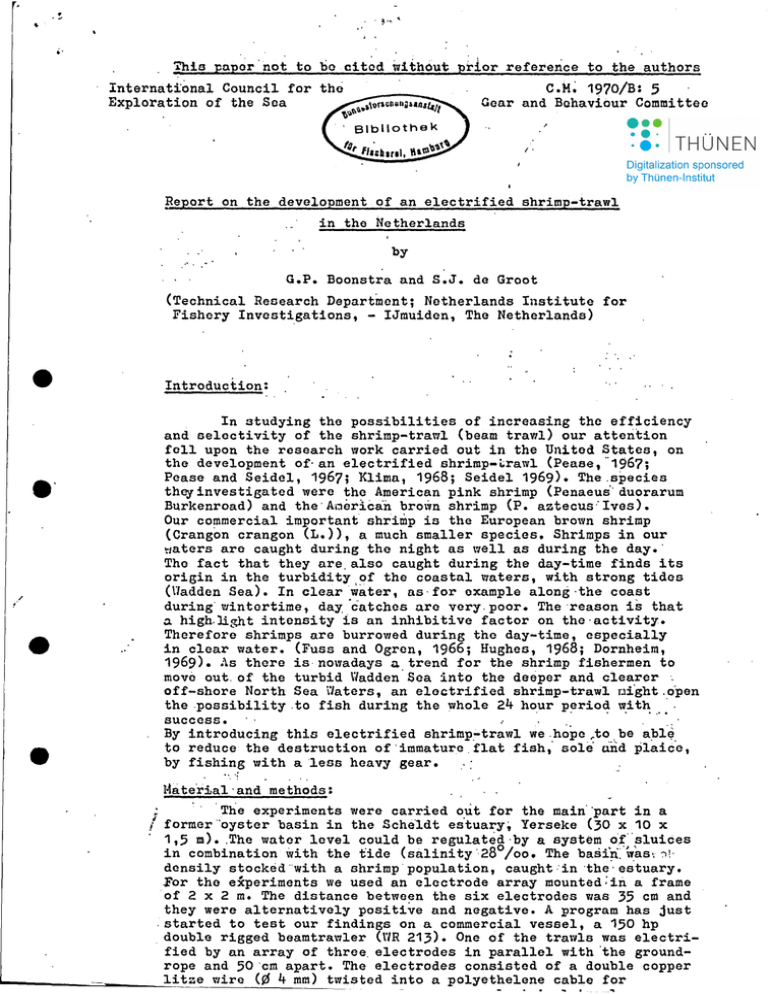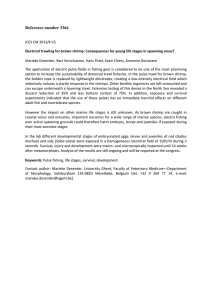Document 11918652
advertisement

.' This papor'not to bo citod without prior reference to theauthors International Council tor tho C.H; 1970/B: 5 Exploration of the Soa Gear and Bohaviour Committee I ' Report on the development of an electrified shrimp-trawl in thc Netherlands by G.P. Boonstra and S.J. de Groot (Technical Research Depart~cnt; Netherlands Institute for Fishery Invcstigations, - IJmuidcn, Thc Netherlands) • .' • • Introduction: In studying thc possibilities of increasing thc efficiency and selectivity of thc shrimp-traWl (beam trawl) our attention fell upon the research work carried out in the Unitod States, on the development of'an electrified shrimp-~rawl (Peaae,-'967; Pcase and Seidel, 1967; Klima, 1968; Seidel 1969). The ,species thqyinvestigated ware thc American pink shrimp (Penaeus'duorarum Burkenroad) and the'A~er1can brown shrimp (P. aztecus:lves). Our commercial important shrimp is thc European brown shrimp (Crangon crangon (t.», a much smaller species. Shrimps in our ~atcrs are caught during thc night as well as during the day.' Thc fact that they are,also caught during the day-time finds its origin in the turbidity of the coastal waters, with strong tidcs (Uadden Sea). In clearwater, aS'for example along·the coast during'wintortime, day 'catchos are very,poor. The'reason i5 that ~ high.light intensity is an inhibitive factor on the-activity. Therefore shrimps are burrowed during thc day-time, cspecially in elcar water. (Fuss and Ogrcn, 1966; Hughas, 1968; Dornheim, 1969). As thcrc isnowadays a trend ror the shrimp fishermen to move out,of the turbid Wadden'Sca into the deeper and elearer, off-shore North Sea uaters, an electrified shrimp-trawl night.opcn thc ,possibility,to fish during the whole 24 hour p~rio~ ~it~,.:' suceess. ' '.,' By introducing this electrified shrimp~trawl we,hoperto,be aplQ. to reduce the destruction of 'immature, flat fish,' sole' und plaicc, by fishing with aleBs hcavy gear • . '. . ~ . , , Ma.terial'and methods: The experiments were earricd o.ut for thc main' 'part in a !! former "oyster basin in thc Scheldt cstuary, Yerseke ( 30 x 10 x 1,5 m) •.Thc water level could be regulated' by a system o( '.sluices in combination with the tide (salinity '28 0 /00. The basi'~: \~as\ ')!, densily stocked'with a shrimp population, eaught:in 'the'estuary. Eor thc experiments we used an elcctrode array mounted:iri a frame of 2 x 2 m. Thc distance betwcen the six electrodes was 35 cm and they were alternatively positive and negative. A program has just ,started to test our findings on a commercial vessel, a 150 hp . double rigged beamtrawler (ITR 213). One or the trawls was electrified by an array of thrce, electrodes in parallel with 'the groundrope and 50 'ern apart. The electrodes consistcd of a double copper litze wirc (ß 4 mm) twisted into a polyethelene cable ror _.~_._ . . . .",.--- T . . . . . _. ~ ~ .. ~ - ~ - - .. • 2 pulse generator was made to our specifications by a private firm. Thc peak voltage can be regulated in steps betwcen 2.5 and 60 V. Thc, pulse frequency can be regulatcd continuously between 1 and 50 impulses per second (i.pos.). Thc faeility to interrupt th~ p.'dls.~. ~,Y.q~,e_;.:w~s 'a.~de,d·l?-tef,. :l~h:::: !?u~se cycle ban 'be interrupted in a,freq'tency of t to-10·Hz~ The"d~schargecapacitors have a total cap~~iti'of 9520 uF to be regulated in steps,'viz. 2 x 34; 9 x' 6'8 arid"13 x 680 uF ~The total number of discharge capaci tors is 1400. They are of a very high quality and can withstand a short circuit. Thc dis charge capacitors arequickly charged by 4 electrolytic buffcr capacitors of 10 ml each. The dis charge capacitors are switched on and-off by silicon eontrolled rectifiers (BCR), whieh are aetivated by the pulse frequency switehing unit. ~he TiH~-::discharging.. time. is maximum: 6, mseo l, the' charging , time is from 14 to 994 msec. depending on the'pulse repetition rate' 14 msec. at 50 Lp.s. and 994 msec~"at 1 Lp.s •• The electrieal resistance of thc eleetrode array was figured to bc about 0,'1 ohm for a commcrcial trawl. ~his figure was fotind to be in agreement with thc· i\!~crican findings (Seidel, 1969). " ' .. A representative part of the results of the experiments in thc oyster basin is given in .TablcI. Thc optimum pulse lcngth (RC) is appr.0.2 msec., although the shrimps still react with pulses of 0~1 msee. A burrowed shrimp in sandy bottom will become as a rule visible after the first pulse, will emerg~ .. ~o~p~etely after the next one, and will jump ai thc third pulse • . "', .~. - 3 ~". • . ", , This secm's to bc' the minimum number of pulses ,rcquired to make a complctely burrowed shrimp . jump high eno~ghto be eaught by thenet. However, this will be on~y ·the ease whe~ thc pulse rate docs not 'exeeed 5 i.p.s ••. The. fact that.,not all: of thc shrimps prcsent between the elee":'" t'rodes'will: jump. ,after the first three pulses, may be due t9 the örientation of thc shrimp (body-axis) towards the elcctric '·:ti~ld. The reaction time was established by counting thenumber 'ot:pulses needpd to makc the shrimp jump at a known number of i.p.s •• Although the pulse shape diffcred from a eapacitor discharge shape bocause of thc long cables (50 m) between pulse generator·and eleetrode array, this did not influcnce the ~eactions (De Groct and Boonstra, 1970). . . The.height of the in~ial jump was estimated to bc about 10 - 20 cm, however, by means of additional swimming shrimps often reached the surface (bottom to surfaee about 60 em). . In the field experiments which only just have started,. we were able to inerease thc total catch with about 5ifA .when the trawl was electrified. Howeyer, in vcry turbid water the catch of the electrified trawl was sometimes evcn lower than thc catch of the noneleetrified trawl. . • • • l - 3 . _.... .. " " , -~~"'" Discussion: :" ,'., A-lready.'from the 'first ~esuits we may conclude, that 1t is possib,le to increase the cateh of 't'heshrim'p... trawl by means of eleetriei ty., '·The, resul ts also confirm tha t the reaetion to eleetriei t'y; of the European,: brown "shrimp is, qui -Ce similar to the reaetion observed in the American pink and brown shrimp (Poase, 1967; Pease and Seid~l, 1967; Klima, 1968;'Seidel, 1969). The optimum pulse length in the experiments uas established as being 0.2 msee~ whieh is in agreement with what Kessler found for the Ameriean pink shrimp, 0.14 mse~ (K~ssler, 1965). The impulse rate, 5 i.p.s., is also quite in ac~ordance with Klima. The voltage given in Table I is the volt~ge between th~ electrodes; no measurements of ~ield strengthswere taken. • • • • The turbidity of the water plays an important role upon the activity cycle of the shrimp~ A high turbidity, a lower light intensity, will aetivate the burrowed shrimp to come out of the sand' even 'during the"day-time (H~ghes, 1968; Dornheim, 1969). These conditions prevail espeeially in the W~dden Sea where shrimps are actually caught on a' commercial scale during the day-time. It i5 verylikely that a shrimp already out of the sand will escape easier with his jump (escape reaction) the electrified shrimptrrwl.The 'electric field extends in front __ ,of the groundrope, and will warn ~ne shrimp sooner of the nearing danger than the g~oundrope of the non-electric trawl. The time interval needed to deburrow will no\v be used for ': escaping. This may be an explanation far the lower eatches d~ring ,theday-time in very turbid waters of the electrified trawl compared with the non-electric trawl. As we have observed an increase 'in thc- 'catch using.: an electrified trawl in less turbid waters compared with the non-electrified trawl ~o oxpcct 'thut 'in tho clourcr offshoro ,. ~ntQrs thc olcctrificd shrimp-trawl may provo to bo uscful. '. ' - 4 References Dornheim, H., 1969. Beiträge zur Biologie der Gärnele Grangon crangon (L.) in der Kieler Bucht. Ber. Dt. rJiss. Komm. Heeresforsch, 20: 179..215.---'-''-" ~, " :, , . " ~ : . .-.. '. ..: . Fuss, G.H. and L.H~ Ogren, 1966. Fäctors affecting'ci.ctivity'and burrowing habits of the pink' shrimp, Penaeus', duorarum Burkenroad. . . Biol. Bull.~ 130:1·70-191·.··· "',' : .. . ;.~:}. " <0( .... Hughes, D.A., 1968.' Factors controllingemergence of pink shrimp (Penaeus duorarum) from the substrate. Biol. Bull., 134:48-59. Kessler, D.W., 1965~ Electrical threshold responses of pink shrimp Penaeus duorarum, Burkenroad. Bull. Mar. Sei., 15:885-895. Klima; E.F., 1968.- 1ihrimp-behavior studies underlying the development of the electric shrimp-trawl system.' Fish. Industr. Res., 4:165-181. Pease, N.L., 1967. The design and field testing of an electroshrimp trawling system. F.A.O. Fish. Rep., 57:513-520. ' . '., PeaseN.L. and ~.R. Seidel, 1967~ Developmen~ of,the electrosh'rimp trawl system. '. Gomm. Fish. Rev., 29 (8-9):58-63. • • Seidel, U.R., 1969. Design, construction and fi&ld testing cf the BGF electric shrimp-trawl system. " ' ~ish. Industr. ~es., 4:213-231.' • • - 5 - Experiments in the oyster basin The resistanee R of the eleetrode array at 7°C is approx. 0.3 ohm. 100% reaetion is reaetion at 60 V 1360 uF during 10 seeonds. S = sand; M = mud. No. I ;;l 53 54 55 56 57 58 59 60 1 61 62 63 64 65 66 67 68 I • 50 50 60 60 60 60 60 60 60 60 60 60 60 60 60 60 60 340 .- 340 680 680 680 680 680 680 680 680 680 680 680 680 680 680 680 ! bottomi reaetion nereentap;e S 50 75 100 100 100 100 100 50 100 30 100 30 100 75 100 80 100 n-- VOltagel.Ca'!?'1 I ~n uF . i.p.s. I 2 2 5 5 5 5 1 3 5 3 2 2 3 3 2 2 s s M M 1-1 s s s s B s s,. .;;> s s " >J ) ) ) ) ) reaetion time .- .after after after after after after after after after after after after after after after after after pulses = 1 sec. pulses = 1t sec. pulses = 1t sec. pulses = 1 sec. pulses = 1 sec. pulses = 1 sec. 5 pulses = 1 sec. 5 pulses = 5 sees. 15 pulses= 1 sec. 5 pulses = 1 sec. 30 pulses= 10 sec. 4 pulses = 2 sees. 20 pulses=10 sees. 6 pulses = 2 sees. 30 pulses= 10sees. 4 pulses = 2 sees. 20pulses =10 sees. 2 3 3 5 5 5 I I .J r--- - - J • • e e ' ", • I I I I ....... , Pulse cycle interruption !- Pulse frequency switching unit 1 - 50 i.p.s. . 10 Hz -~.~ ~ ' .. - - . -- - . ; i, I ! - ._.- 1 , Mains 24 VOC , , . I i I I I , \,\, Convertor " oe - AC i,' " I, ; I' '-'--~' -_. -. __ _-_ .. .. -. ~ I I : Reetifier BuHer Capacit..:rs 40 mF ti + I\C - OC I I 0'\ r I I i. d ;' I . \ ! , i - + Discharge Capacitors 9520 uF - f ~ i : \--------_.. --- -- --- .. _- -_. .... . 4·' • --- -- _. ._~- ...... ~. - 0 •• . .... . - - - ..... Eleetr~de Block diagram .f the pulse-generator.




